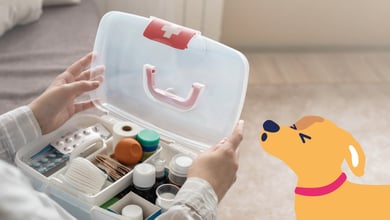Fall Health and Safety Tips for Pets

Fall is a beautiful time to get out and enjoy the great outdoors with your pet. As the leaves change and the temperatures drop, the autumn season also raises specific health and safety concerns for our furry friends.
To ensure your pet stays healthy and protected, read on for some important fall safety tips and other helpful information.
Fall Pet Health Concerns
In this section, I'll discuss some of the most common fall health concerns that pet parents should be aware of and how to prevent and address them.
Seasonal Allergies
Cats and dogs can both be sensitive to fall allergens like ragweed, mold spores, or even dust. Watch for symptoms like excessive sneezing, scratching, or watery eyes.
Does Your Pet Have Skin Allergies?
1. How frequently does your pet seem itchy?
2. Where does your pet scratch the most?
3. Which season is your pet’s symptoms the most noticeable?
4. How often does your pet seem uncomfortable?
5. Can you see any of the following symptoms on your pet’s skin?
6. Is your pet experiencing any of the following symptoms?
View Results
Arthritis
Monitor for signs of joint pain in older pets, especially cats. Consider supplements or pain relief options. Dogs may also experience arthritis, especially in their hips and elbows.
Parasites
Pets are susceptible to fleas and ticks, especially during the fall months. As the cooler weather sets in, pests like fleas and ticks might seek the warmth of our homes and pets.
Regularly check your pet’s coat for any unwanted guests, especially after they've been outdoors. Use vet-recommended preventative treatments and consider treating your home environment if you notice an infestation.
Pet Poisons
Be cautious of rodenticides, antifreeze, fertilizers, and other harmful household chemicals. Store them securely and clean up spills immediately.
Both cats and dogs can be poisoned by everyday household items if ingested.
Fall Pet Safety Considerations
It's important to be mindful of the potential safety concerns that can arise for our pets in the fall. From shorter days to seasonal hazards like fallen leaves and Halloween festivities, there are several factors to keep in mind.
Here are some tips to remember:
Adjust Walks
Shorter days require safety precautions for evening walks. Use reflective gear or LED collars, and stick to well-lit routes.
Pet Proof Environmental Hazards
Keep your home environment clean and free from potential dangers, such as antifreeze, rodenticides, and choking hazards.
Are You a Pet Safety Expert?
1. Which one of the plants below is toxic to cats if ingested?
2. Which of the foods below is generally considered safe for your dog to eat?
3. Above what temperature is too hot to leave a pet in your car?
4. Which kind of leash is the safest to walk your dog?
5. True or False: If a medication is safe for humans, it is probably safe for pets.
6. What should you do if you think your pet ate something toxic?
View Results
Are You a Pet Safety Expert?
1. Which one of the plants below is toxic to cats if ingested?
2. Which of the foods below is generally considered safe for your dog to eat?
3. Above what temperature is too hot to leave a pet in your car?
4. Which kind of leash is the safest to walk your dog?
5. True or False: If a medication is safe for humans, it is probably safe for pets.
6. What should you do if you think your pet ate something toxic?
Share Quiz
Choose Pet-Safe Plants
Many plants, including popular fall additions like chrysanthemums, autumn crocus, and Thanksgiving cactus, are toxic to pets.
Make sure that the plants you bring inside are feline and canine-friendly.
Remove Fallen Leaves
Your pet may be tempted to eat fallen leaves or dangerous mushrooms, so watch for signs of tummy troubles and monitor what your pet might pick up during outdoor play or potty sessions.
Monitor Halloween Scaries
Keep chocolate, candies, and Halloween decorations out of your pet’s reach. Be aware that both cats and dogs can be frightened by loud noises and commotion.
Make sure your pet is secured in a room or crate when opening the door for trick-or-treaters.
Plan Ahead for Storms
Have an emergency kit ready and create a safe space for your pet in case of severe weather. Both cats and dogs need to be prepared for emergencies, such as hurricanes, floods, or power outages.
Cool-Weather Comfort
As the weather cools down, let’s discuss how to keep your pet comfortable and warm. In this section, I'll explain how to create a cozy environment for your cat or dog during the cool fall months.
Create a Grooming Routine
You might notice a thickening of your pet's coat as your pet’s fur adapts to the cooler weather. Regular brushing during this time helps manage excess hair and ensures a healthy coat.
For cats, this is especially important to prevent hairballs. For dogs, it helps remove loose hair and distribute natural oils.
Keep Indoor Temperatures Toasty
Maintain a consistent indoor temperature (65-70 degrees) to keep your pet comfortable. Both cats and dogs appreciate a moderately warm environment, especially as the weather cools.
Make a Comfy Den
Provide a warm, comfortable bed or cozy pet space, especially for older or short-coated pets. Cats often enjoy enclosed or cave-like beds, while dogs may prefer a traditional bed or a heated pad.
Dress Your Pet for Fall
Consider sweaters or jackets for dogs in colder climates. While cats typically have thicker coats, some breeds or older cats may benefit from additional warmth.
Fall Pet Wellness Recommendations
To maintain your pet's health and well-being, it's important to schedule regular veterinary checkups and pay attention to any changes in their behavior or health.
Veterinary Visits
Schedule regular checkups to monitor your pet's health and receive vaccinations and parasite prevention recommendations.
Should My Pet Be Seen by a Veterinarian?
1. Have you noticed changes in your pet’s appetite?
2. Does your pet have diarrhea or loose stools?
3. Have you noticed changes in your pet’s thirst/water consumption?
4. Is your pet having accidents in the house?
5. Is your pet pacing and unable to settle?
6. Is your pet panting more than usual?
7. Is your pet whining or vocalizing more than usual?
8. Is your pet shaking more than usual?
9. Is your pet hiding or avoiding physical contact more than usual?
10. Is your pet more lethargic and sleeping more than usual?
11. Are you concerned about changes in your pet’s behavior?
12. Is your pet scratching their ears?
13. Is your pet licking their paws more than usual?
14. Does your pet have a rash?
15. Is your pet moving more slowly than usual or having a harder time getting up or down?
View Results
Should My Pet Be Seen by a Veterinarian?
1. Have you noticed changes in your pet’s appetite?
2. Does your pet have diarrhea or loose stools?
3. Have you noticed changes in your pet’s thirst/water consumption?
4. Is your pet having accidents in the house?
5. Is your pet pacing and unable to settle?
6. Is your pet panting more than usual?
7. Is your pet whining or vocalizing more than usual?
8. Is your pet shaking more than usual?
9. Is your pet hiding or avoiding physical contact more than usual?
10. Is your pet more lethargic and sleeping more than usual?
11. Are you concerned about changes in your pet’s behavior?
12. Is your pet scratching their ears?
13. Is your pet licking their paws more than usual?
14. Does your pet have a rash?
15. Is your pet moving more slowly than usual or having a harder time getting up or down?
Share Quiz
Fall-Specific Concerns
Discuss any changes in your pet's behavior or health with your veterinarian. Both cats and dogs may experience changes in their behavior or health during the fall season.
Conclusion
Autumn is a beautiful season that brings its own challenges for pet parents. By following these tips and staying alert to potential hazards, you can help your cat or dog enjoy a healthy and happy season.
For personalized recommendations for your pet, schedule an in-home visit with one of our experienced veterinarians.
Get Your Pet’s Health Checked Out at Home
Say goodbye to stressful vet visits and hello to a comfortable wellness exam in your pet's favorite spot.
Frequently Asked Questions
How do I train my dog to avoid leaves?
Use commands like "leave it" when they approach leaves and reward them for listening. Consistent training and positive reinforcement will help them learn over time.
Which dog breeds are prone to fall allergies?
Some commonly affected breeds include Golden Retrievers, Labrador Retrievers, Boxers, Bulldogs, Dalmatians, and Terriers. However, any dog can develop allergies. Always monitor for signs like itching or respiratory issues.
How to keep cats from eating plants?
To deter cats from eating plants, provide pet-safe grasses for them to munch on, use pet-safe deterrent sprays on plants, place plants in inaccessible areas, or choose non-toxic plants.
How often should a vet see my cat in the fall season?
Adult cats between 1 and 7 years of age should have an annual wellness exam, while senior cats (8 years and older) require checkups at least twice a year, including blood work. Especially in the fall, if you observe any health changes in your cat, a vet visit is recommended regardless of age.






![Preparing Your Pet for Daycare or Boarding [Printable Checklist]](https://bettervet.com/hs-fs/hubfs/pet-boarding-facility-employee-playing-with-dog.png?width=420&height=220&name=pet-boarding-facility-employee-playing-with-dog.png)